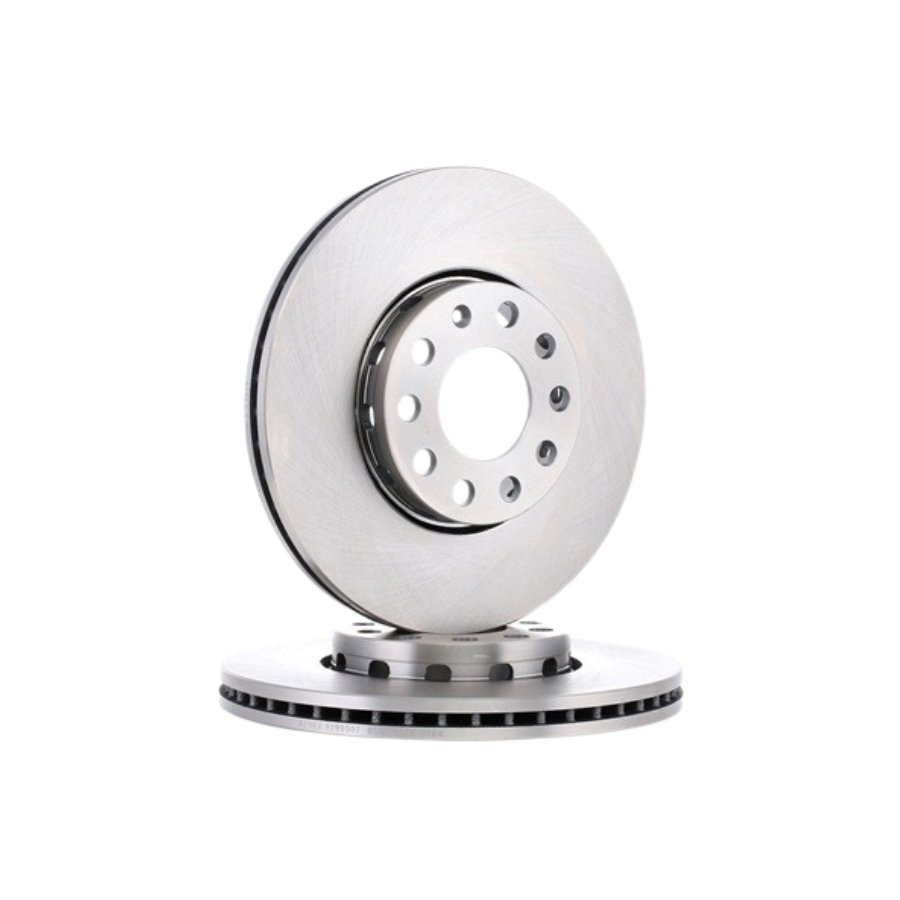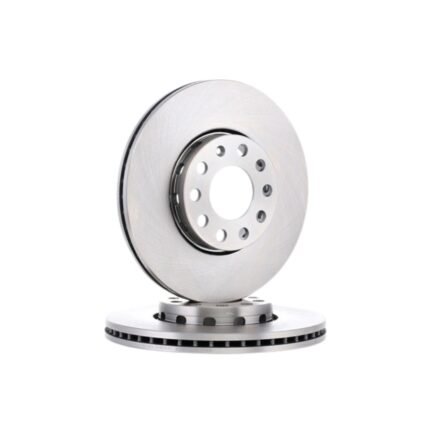Get Volkswagen Passat (B5) Front Brake Disc 8E0615301Q in Kenya
The brake disc, also known as a rotor, is a critical component in a vehicle’s braking system. It plays a fundamental role in ensuring that a car can decelerate or come to a stop safely and efficiently. This part works in tandem with other components such as the brake pads, calipers, and brake fluid to create the friction necessary to slow down the vehicle. Understanding the function, design, types, materials, signs of wear, and maintenance of brake discs is essential for anyone interested in automotive technology or vehicle maintenance.
Function of the Brake Disc
The primary function of the brake disc is to provide a surface for the brake pads to clamp onto, thereby creating friction that slows down the vehicle. When you press the brake pedal, hydraulic pressure is generated in the brake lines, pushing the calipers to squeeze the brake pads against the rotating brake disc. The friction generated between the pads and the disc converts the vehicle’s kinetic energy into heat, effectively reducing its speed or bringing it to a halt.
Brake discs are most commonly used in disc brake systems, which are found on most modern vehicles, especially on the front wheels. They are preferred over drum brakes due to their superior performance in terms of stopping power, heat dissipation, and overall reliability.
Design and Components of a Brake Disc
Brake discs are relatively simple in design but are engineered to withstand high levels of stress and heat. The main components of a brake disc include:
- Disc Surface: This is the flat, smooth surface on which the brake pads make contact. The surface must be precise and smooth to ensure even wear of the brake pads and effective braking performance.
- Venting (in vented discs): Many brake discs are vented, meaning they have a set of internal vanes or channels between two disc surfaces. These vents allow air to flow through the disc, enhancing cooling and reducing the risk of brake fade during prolonged or intense braking.
- Hub: The hub is the central part of the brake disc that attaches to the vehicle’s wheel hub. It’s through the hub that the disc is connected to the axle, allowing it to rotate with the wheel.
- Mounting Holes: Brake discs have mounting holes that align with the wheel hub’s studs or bolts. These holes allow the disc to be securely fastened to the vehicle.
Types of Brake Discs
Brake discs come in various types, each designed for specific applications, driving conditions, and performance requirements:
- Solid Discs: These are the simplest type of brake discs, consisting of a single, solid piece of metal. They are typically used on smaller, less powerful vehicles or on the rear wheels, where less braking force is required. Solid discs are less expensive and simpler to manufacture but are more prone to heat buildup, which can lead to brake fade.
- Vented Discs: Vented brake discs are the most common type used in modern vehicles. They have an internal structure with air channels that help dissipate heat more effectively. Vented discs are typically used on the front wheels, where braking demands are higher.
- Drilled Discs: These discs have holes drilled through them, which helps improve heat dissipation and reduce weight. Drilled discs are often found on high-performance vehicles and are designed to handle the extreme temperatures generated during aggressive braking. The holes also help channel away water, improving braking performance in wet conditions.
- Slotted Discs: Slotted discs have grooves or slots machined into the surface. These slots help evacuate gas, dust, and water from between the brake pad and disc, improving overall braking performance and preventing pad glazing. Slotted discs are commonly used in performance and racing applications.
- Drilled and Slotted Discs: These combine the features of both drilled and slotted discs, offering enhanced cooling, water dispersion, and brake pad cleaning. They are often used in high-performance or sports vehicles where maximum braking efficiency is required.
- Floating Discs: Floating or two-piece discs consist of a separate central hub and outer disc ring, connected by a series of fasteners. This design allows the disc ring to expand and contract independently of the hub, reducing the risk of warping under high temperatures. Floating discs are commonly used in racing and high-performance applications.
Materials Used in Brake Discs
The material of a brake disc is crucial to its performance, durability, and heat management capabilities. Common materials include:
- Cast Iron: This is the most commonly used material for brake discs due to its excellent heat capacity, durability, and cost-effectiveness. Cast iron discs are found in the majority of road vehicles.
- Carbon Composite: Used in high-performance and racing vehicles, carbon composite discs are extremely lightweight and can withstand very high temperatures. However, they are much more expensive than cast iron discs and are typically reserved for specialized applications.
- Ceramic Composite: Ceramic composite brake discs offer superior performance in terms of heat resistance, weight reduction, and longevity. They are often found in high-end sports cars and racing vehicles but come at a significantly higher cost.
- Steel: Steel discs are less common but are used in some performance applications. They offer good strength and durability but can be heavier than other materials.
Signs of Wear and Failure
Like all components of the braking system, brake discs are subject to wear and tear over time. Signs that your brake discs may need attention or replacement include:
- Warping: Heat and stress can cause brake discs to warp, leading to a pulsating or vibrating sensation when braking. Warped discs should be replaced as they can compromise braking performance.
- Scoring: Deep grooves or scores on the disc surface are a sign of excessive wear, often caused by debris or worn brake pads. Scored discs reduce braking efficiency and should be resurfaced or replaced.
- Cracking: Cracks, particularly around the drilled holes in performance discs, can occur due to thermal stress. Cracked discs are dangerous and should be replaced immediately.
- Thickness Variation: Uneven wear on the disc can lead to thickness variation, which causes brake judder. Discs that are too thin or uneven should be replaced to ensure safe braking.
- Rust and Corrosion: While some surface rust is normal, excessive corrosion can weaken the disc and affect braking performance. Severely corroded discs should be replaced.
Benefits Of A Brake Disk
1. Superior Stopping Power
- Efficient Heat Dissipation: Brake discs are exposed directly to air, which allows them to dissipate heat more effectively than drum brakes. This efficient heat dissipation reduces the risk of brake fade, which can occur when brakes overheat and lose effectiveness.
- Consistent Performance: Because they handle heat so well, brake discs provide consistent braking performance even during prolonged or aggressive use, making them ideal for vehicles that require high stopping power, such as sports cars and trucks.
2. Enhanced Safety
- Better Control: Brake discs allow for more precise control over braking, contributing to better vehicle handling and safety, especially during emergency stops. This is because they provide a more linear response compared to drum brakes.
- Reduced Risk of Brake Fade: With their superior heat management, brake discs significantly reduce the risk of brake fade, ensuring that the brakes remain effective even after repeated use in demanding conditions.
3. Improved Wet Weather Performance
- Self-Cleaning Action: The open design of brake discs allows water to be quickly expelled when the brakes are applied, which reduces the risk of reduced braking performance in wet conditions. Some brake discs are also drilled or slotted, which further helps in clearing water and maintaining effective braking.
4. Lower Maintenance Requirements
- Ease of Inspection: Brake discs are easier to inspect than drum brakes because their condition can be visually assessed without removing other components. This simplifies routine maintenance checks.
- Longer Lifespan: High-quality brake discs can last longer than drum brakes, especially when used in conjunction with quality brake pads. They are also less prone to issues like glazing, which can occur in drum brakes.
5. Lighter Weight and Improved Efficiency
- Reduced Unsprung Weight: In performance and racing applications, lightweight materials like carbon composite or ceramic composite discs are used, which reduce the unsprung weight of the vehicle. This reduction in weight improves overall vehicle handling and efficiency.
- Fuel Efficiency: Lighter brake discs can contribute to better fuel efficiency, especially in performance vehicles where every kilogram matters.
6. Compatibility with Modern Braking Technologies
- Antilock Braking System (ABS): Brake discs are highly compatible with modern braking technologies like ABS. The precise control and rapid response of brake discs allow ABS systems to function more effectively, preventing wheel lock-up during hard braking.
- Electronic Stability Control (ESC): Brake discs work well with ESC systems, which require quick and accurate modulation of braking force to maintain vehicle stability during evasive maneuvers or on slippery surfaces.
7. Better Performance in High-Speed Applications
- High-Speed Stability: Brake discs are better suited for high-speed vehicles because they can handle the extreme conditions generated during high-speed braking. They offer better stability and less vibration at high speeds compared to drum brakes.
- Race-Ready Performance: For motorsports and high-performance vehicles, brake discs are essential. Their ability to withstand high temperatures, coupled with their superior stopping power, makes them the preferred choice in racing.
8. Aesthetic Appeal
- Modern Look: Brake discs often contribute to the aesthetic appeal of a vehicle, especially when paired with alloy wheels that expose the braking system. Drilled and slotted discs, in particular, are often considered stylish and sporty.
- Customization Options: Enthusiasts can customize their brake discs, choosing from different designs, materials, and finishes to match the vehicle’s overall look and performance goals.
9. Reduced Noise and Vibration
- Quieter Operation: Compared to drum brakes, disc brakes typically generate less noise, especially when high-quality pads are used. This is because the design of brake discs allows for smoother and more controlled contact between the pads and the rotor.
- Less Vibration: Brake discs, particularly those that are well-maintained and free from warping, produce less vibration during braking, contributing to a more comfortable driving experience.
10. Ease of Replacement and Upgrading
- Simple Replacement: Brake discs are relatively straightforward to replace, making them a more convenient option for both regular maintenance and performance upgrades.
- Aftermarket Options: There is a wide range of aftermarket brake discs available, allowing vehicle owners to upgrade to high-performance or specialized discs that suit their driving style and requirements. Whether it’s for better heat dissipation, improved aesthetics, or enhanced performance, the options are plentiful.
Follow us on Facebook for more parts.




